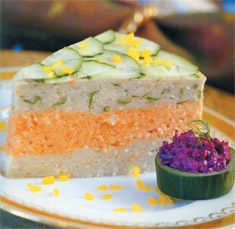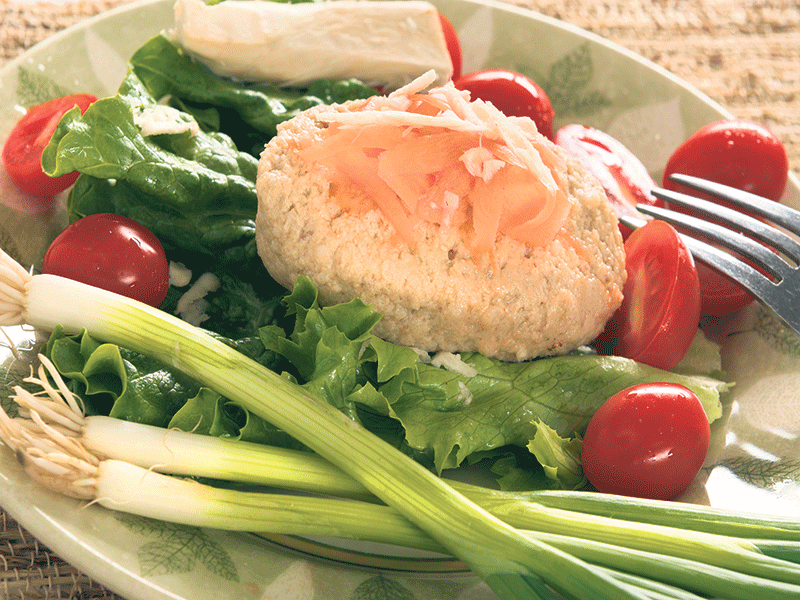Good Shabbos, Shabbat Shalom! Gefilte fish is often served for Shabbat and it is very popular for the High Holidays.
In many families, it was not unusual to find a live carp splashing around in the bathtub, flipping its tail back and forth! The fish would be killed, skinned, filleted, and then chopped in a large wooden bowl with a ‘hackmesser’ (chopping knife). Oy, so much work! The fish balls would be placed in a large pot and simmered with fish heads and bones, carrots and onions. The fish bones would cause the cooking liquid to become jelly-like when chilled. Some people love the jelly, while others hate it with a passion!
Seasonings would vary, depending on a person’s origins. Litvaks used salt and lots of pepper, while Jews of Polish origin added sugar to the fish. Romanians and Litvaks stuffed the fish skin and then cooked it, which is how it got its name. ‘Gefilte’ fish means ‘stuffed’ fish.
The fish mixture would also vary, depending on what was available in different parts of the country. In Winnipeg, where I grew up, my late mother, Belle Rykiss (z’l), made fabulous gefilte fish using a mixture of whitefish, pickerel and pike.
She would grind the fish fillets together with onions and carrots in her old-fashioned meat grinder. Carp was never included in Mom’s gefilte fish as it made the color too dark. She then combined the ground fish with eggs in her electric mixer, adding a generous amount of salt and pepper, a splash of cold water, a little matzo meal, and a spoonful of sugar. She would mix the fish until it climbed up the beaters, then scraped it down and beat it some more. She then wet her hands with cold water so the fish balls wouldn’t stick to them, and would shape the fish mixture into oval balls. She simmered the fish slowly with sliced carrots and onions until they were puffy and tender, about 2 hours. Nothing tasted better!
My mother always looked for ways to save time, so she was thrilled when she found out that she could make terrific gefilte fish in her food processor. When I was a young child, she once tried to save time by cooking her gefilte fish in her pressure cooker. We had gefilte fish all over the kitchen ceiling!
My late Auntie Clara would usually fry her gefilte fish and it was so good. She made thick fish patties and fried them on both sides until they were nicely browned, using her big, square electric frying pan. She also sautéed chopped onions (usually 1 onion per pound of fish), then added enough water to cover the fish partway; she covered the pan and steamed the fish until it was cooked through, about 1 hour.
Nowadays, using frozen logs of gefilte fish has become a convenient timesaver for today’s balabusta. The parchment-wrapped loaves can be prepared in several ways. They can be cooked from frozen on the stovetop in a pot of simmering water along with slice d carrots and onions. Some recipes call for unwrapping the frozen loaf, placing it into a greased loaf pan and topping it with about a cup of salsa (see Super Salsa, below) or tomato sauce. Bake the loaf uncovered for about 1 hour at 350 F, until golden.
d carrots and onions. Some recipes call for unwrapping the frozen loaf, placing it into a greased loaf pan and topping it with about a cup of salsa (see Super Salsa, below) or tomato sauce. Bake the loaf uncovered for about 1 hour at 350 F, until golden.
If you’re expecting a crowd, try my Three-Color Gefilte Fish Loaf or my Gefilte Fish Ring for an elegant presentation. Serve with ‘chrain’ (horseradish) if you’re traditional, or for a more modern twist, serve with Super Salsa.
THREE-COLOR GEFILTE FISH LOAF
Adapted from Norene’s Healthy Kitchen
Looks complicated—cooks easily! This layered loaf looks elegant and tastes terrific. You won’t have to fish for compliments when you serve this to your guests. They’ll fall for it—hook, line, and sinker!
Fish Mixture:
2 loaves frozen gefilte fish loaf, thawed (22 oz/623 g each)
2 large eggs, lightly beaten
1/2 tsp salt
1/2 tsp freshly ground black pepper
1/2 tsp garlic powder
First Layer:
1/3 of the Fish Mixture
1/2 cup seeded and diced red pepper
2 green onions, diced
2 Tbsp minced fresh dill
Second Layer:
1/3 of the Fish Mixture
1 pkg (10 oz/300 g) frozen spinach, thawed and squeezed dry
2 Tbsp minced fresh basil or parsley
Third Layer:
1/3 of the Fish Mixture
1 medium sweet potato, cooked and mashed (or 1 cup cooked mashed carrots)
1 Tbsp minced fresh dill or parsley
Preheat the oven to 350°F. Spray two 9 x 5-inch loaf pans with cooking spray.
Fish Mixture: In a large bowl, combine the gefilte fish mixture, eggs, salt, pepper, and garlic powder. Mix well. Divide the mixture in thirds and place in three separate bowls.
First Layer: Combine the fish mixture, red pepper, green onions, and dill; mix well. Divide in half and spread evenly in each prepared pan to make a first layer.
Second Layer: Combine the fish mixture, spinach, and basil; mix well. Divide in half and spread evenly in each pan to make a second layer.
Third Layer: Combine the fish mixture, sweet potato, and dill; mix well. Divide in half and spread evenly in each pan to make a third layer.
Bake, uncovered, for 1 hour. When done, the top layer should be firm to the touch and the edges should pull away from the sides of the pan. Remove from oven and cool for 20 to 30 minutes.
Yield: 2 loaves, 16 to 20 servings. Serve with horseradish or salsa.
GEFILTE FISH RING
Adapted from Healthy Helpings/MealLeaniYumm!
Instead of making gefilte fish balls, why not try this pretty presentation? For a nice twist, squeeze a bit of fresh lime juice into horseradish at serving time.
3 carrots
2 Tbsp fresh dill
2 medium Spanish or Vidalia onions, chopped
3 lb (1.4 kg) minced fish (a combination of whitefish, pike and dore)
4 eggs
1 1/2 cups cold water
6 Tbsp matzo meal
3 to 4 tsp salt (to taste)
2 tsp pepper
3 Tbsp sugar
Preheat oven to 325 F. Finely mince carrots and dill in the processor, using the Steel Blade. Set aside in a small bowl. Chop onions; transfer them to the large bowl of an electric mixer. Add ground fish, eggs, water, matzo meal and seasonings to onions. Mix on medium speed for 15-20 minutes. Fold in carrot mixture at the end to avoid changing the colour of the fish.
Spread mixture in a sprayed 10-inch Bundt pan; it will be almost full. Place in a pan of hot water so water comes 1 inch up the sides of the Bundt pan. Bake uncovered at 325 F for 1 hour. Cover loosely with foil and bake 1 1/2 hours longer, until fish tests done. (See below.)
Let cool for 20 minutes. Carefully unmold onto a serving plate. Wipe any juices that collect on the plate. When completely cool, cover and refrigerate. (Can be prepared up to 2 days in advance.)
Garnish with tomato and cucumber slices. Serve with horseradish. Super Salsa is great with the Tex-Mex version (below).
Yield: 24 slices. Do not freeze. Leftovers keep 3-4 days in the refrigerator.
Norene’s Notes:
How to test for doneness and how to unmold: Top of fish should be firm to the touch and edges should pull away from sides of pan. Insert a wooden skewer into the fish halfway between the center and the outside edge. Skewer should come out clean. Cool for 20 minutes. Loosen fish with a long, narrow spatula. Cover pan with a serving plate. Invert and shake gently to unmold.
TEX-MEX GEFILTE FISH: Use 3 lb (1.4 kg) minced red snapper fillets. Omit dill. Add 1/4 cup chopped cilantro, 1 jalapeno pepper and 1 red bell pepper, seeded and diced, plus 1/2 tsp cumin to fish. Cook as directed. Serve with Super Salsa (below) or horseradish to which you’ve added a squeeze of fresh lime juice.
SUPER SALSA
This scrumptious salsa is great with fish and also makes a terrific dip for assorted veggies, pita chips, or challah.
6 to 8 Italian plum tomatoes, finely chopped
2 cloves garlic, crushed
1/4 cup coriander or parsley, minced
1 jalapeno pepper, seeded and minced
2 Tbsp fresh basil, minced (or 1 tsp dried)
2 green onions, chopped
1 Tbsp olive oil
2 Tbsp fresh lemon juice
Salt and pepper
Dash of cayenne or hot sauce
Combine all ingredients and mix well. The processor does a quick job of chopping the vegetables.
Makes about 3 cups. Keeps 2 to 3 days in the refrigerator. Do not freeze.
Norene Gilletz is the leading author of kosher cookbooks in Canada. She is the author of eleven cookbooks and divides her time between work as a food writer, food manufacturer, consultant, spokesperson, cooking instructor, lecturer, and cookbook editor. Norene lives in Toronto, Canada and her motto is “Food that’s good for you should taste good!” For more information, visit her website or email her at [email protected].
